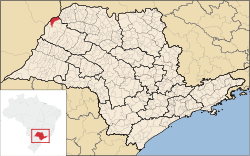Ilha Solteira | |
|---|---|
 View of Ilha Solteira | |
 Location in São Paulo state | |
| Coordinates: 20°25′38″S 51°20′37″W / 20.42722°S 51.34361°W | |
| Country | Brazil |
| Region | Southeast |
| State | São Paulo |
| Area | |
| • Total | 653 km2 (252 sq mi) |
| Elevation | 347 m (1,138 ft) |
| Population (2020 [1]) | |
| • Total | 26,788 |
| • Density | 41/km2 (110/sq mi) |
| Time zone | UTC-03:00 (BRT) |
| • Summer (DST) | UTC-02:00 (BRST) |
| Website | www |
Ilha Solteira is a municipality in the state of São Paulo in Brazil. The population is 26,788 (2020 est.) in an area of 653 km².[2] The elevation is 335 m. The nearby Ilha Solteira Dam created a reservoir in the Paraná River.
Media
[edit]In telecommunications, the city was served by Companhia de Telecomunicações do Estado de São Paulo until 1975, when it began to be served by Telecomunicações de São Paulo.[3] In July 1998, this company was acquired by Telefónica, which adopted the Vivo brand in 2012.[4]
The company is currently an operator of cell phones, fixed lines, internet (fiber optics/4G) and television (satellite and cable).[4]
References
[edit]- ^ IBGE 2020
- ^ Instituto Brasileiro de Geografia e Estatística
- ^ "Creation of Telesp - April 12, 1973". www.imprensaoficial.com.br (in Portuguese). Retrieved 2024-05-26.
- ^ a b "Our History - Telefônica RI". Telefônica. Retrieved 2024-05-26.



Well, that’s interesting to know that Psilotum nudum are known as whisk ferns. Psilotum nudum is the commoner species of the two. While the P. flaccidum is a rare species and is found in the tropical islands. Both the species are usually epiphytic in habit and grow upon tree ferns. These species may also be terrestrial and grow in humus or in the crevices of the rocks.
View the detailed Guide of Psilotum nudum: Detailed Study Of Psilotum Nudum (Whisk Fern), Classification, Anatomy, Reproduction